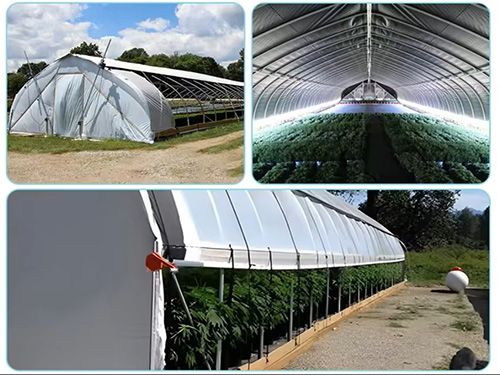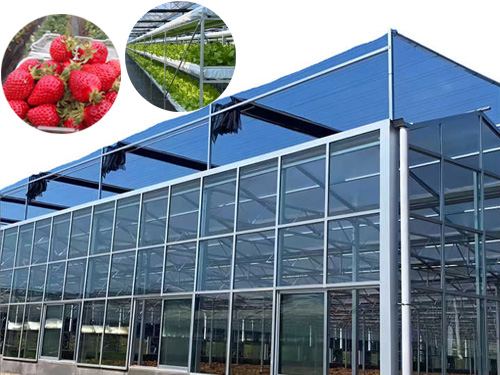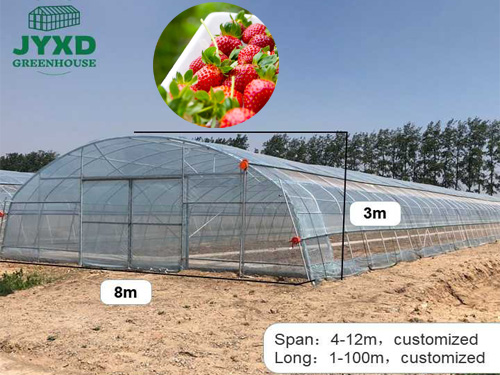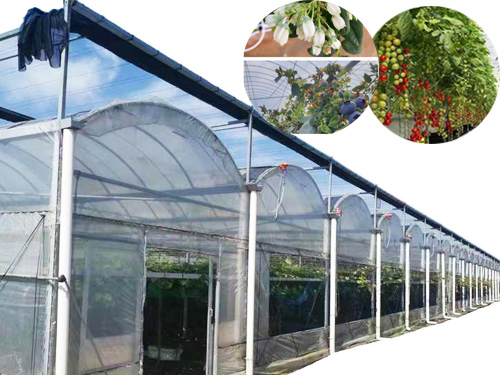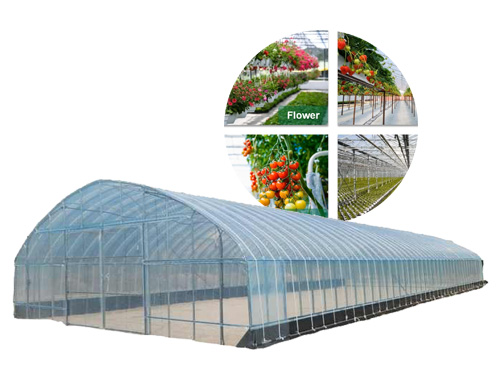NEWS DETAILS
NEWS INFORMATION
Greenhouse Waste Management: How to Recycle and Dispose of Greenhouse Waste
AUTHOR:jyxd-greenhouse DATE:2025-03-10 14:11:24 HITS:151
Greenhouses are crucial in modern agriculture, providing an environment for growing crops in controlled conditions. However, just like any agricultural operation, they generate waste that needs to be managed responsibly. Effective greenhouse waste management is vital not only for environmental sustainability but also for maintaining healthy growing conditions and reducing operational costs. This article explores practical strategies for recycling and disposing of greenhouse waste, helping greenhouse owners implement eco-friendly practices while ensuring smooth operations.
1. Types of Greenhouse Waste
Greenhouse operations generate a variety of waste materials, each requiring specific management strategies. Understanding the types of waste generated is the first step in creating a waste management plan. Common types of greenhouse waste include:
• Organic Waste: Plant residues, leaves, stems, and other organic material from trimming, harvesting, and general maintenance.
• Plastic Waste: Pots, trays, plant tags, greenhouse film, and other plastic materials used in the greenhouse setup and cultivation processes.
• Chemical Waste: Pesticides, herbicides, fertilizers, and other chemicals that can accumulate in used containers or excess quantities.
• Soil and Growing Medium Waste: Soil from plant containers or hydroponic systems that may need to be replaced or disposed of.
• Greenhouse Construction and Repair Debris: Materials such as broken glass, metal, and other construction or repair waste from maintaining greenhouse structures.
• Water Waste: Excess water or wastewater from irrigation systems, especially in hydroponic or aquaponic greenhouses.
Each of these waste categories requires a tailored approach to recycling, reuse, or proper disposal to ensure minimal environmental impact.
2. Strategies for Recycling and Reusing Greenhouse Waste
Implementing a recycling program can help reduce the environmental footprint of greenhouse operations while also providing opportunities for cost savings. Here are some key strategies to recycle and reuse greenhouse waste:
2.1 Composting Organic Waste
Organic waste is one of the most significant types of waste generated in greenhouses. Instead of disposing of plant residues and organic matter, composting is an effective way to recycle these materials. Composting turns plant matter into nutrient-rich organic fertilizer that can be used to enrich the soil in your greenhouse or garden.
To set up an efficient composting system, consider the following steps:
• Collect plant waste, such as leaves, stems, and spent crops.
• Add brown materials like straw, wood chips, or paper to balance the carbon-to-nitrogen ratio.
• Monitor moisture levels and aerate the pile regularly to encourage decomposition.
• Use finished compost to improve soil structure and fertility in your greenhouse growing beds.
Composting organic waste not only reduces the amount of waste sent to landfills but also supports sustainable farming practices by providing valuable soil amendments.
2.2 Recycling Plastic Waste
Plastic is commonly used in greenhouses for various purposes, including pots, trays, irrigation systems, and greenhouse covers. Recycling plastic waste is an essential step in reducing the greenhouse’s environmental impact.
• Plastic Pots and Trays: Clean and collect plastic plant containers and trays for recycling. Many suppliers offer take-back programs, or you can find local recycling centers that accept horticultural plastic.
• Greenhouse Films and Covers: When greenhouse films become torn or worn out, consider recycling them instead of sending them to the landfill. Some recycling centers specialize in greenhouse plastic films and can repurpose the material for new products.
• Plastic Plant Tags: Use biodegradable plant markers or collect plastic plant tags for recycling. Recycling companies can process these plastics into new items like containers, films, or construction materials.
By segregating and recycling plastic waste, you can significantly reduce the amount of non-biodegradable material that accumulates in landfills.
2.3 Repurposing Soil and Growing Media
Soil and growing media can accumulate over time, especially in soil-based greenhouse systems. Rather than discarding old soil, it can be reused or repurposed in various ways:
• Reusing Soil: In soil-based systems, soil can be refreshed and reused by adding organic amendments like compost, biochar, or organic fertilizers to restore its nutrient content.
• Hydroponic and Aquaponic Systems: In hydroponic systems, used growing media like coco coir or perlite can be sterilized and reused in future growing cycles. In aquaponic systems, the water and nutrients can be filtered and reused as part of the integrated ecosystem.
By repurposing soil and growing media, you not only minimize waste but also lower the cost of buying new soil or media.
2.4 Chemical Waste Disposal
Chemical waste, including pesticides, herbicides, and fertilizers, needs to be disposed of carefully to prevent contamination of the environment. Here are some responsible ways to handle chemical waste:
• Store Properly: Always store chemicals in their original containers with clear labels.
• Use Refillable Containers: Consider using refillable containers for your chemicals to reduce waste from packaging.
• Return Excess Chemicals: If you have unused chemicals or expired products, check with your local agricultural supplier to see if they offer take-back programs.
• Proper Disposal: For chemicals that cannot be reused, dispose of them at designated hazardous waste facilities. Never pour chemicals down drains or dump them in regular trash.
Proper chemical waste management protects both your crops and the surrounding environment, preventing harmful runoff and contamination.
3. Reducing Water Waste in Greenhouses
Water waste is another critical aspect of greenhouse waste management, especially in water-intensive systems like hydroponics or aquaponics. There are several ways to reduce water waste and increase efficiency:
• Implementing Closed-Loop Irrigation Systems: A closed-loop system recycles water, reducing the need for constant replenishment. This system collects and filters runoff water before returning it to the plants.
• Using Rainwater Harvesting: Harvesting rainwater for irrigation purposes reduces dependency on municipal water sources and minimizes wastewater runoff.
• Efficient Irrigation Methods: Drip irrigation and automated irrigation systems ensure that water is delivered directly to the plants’ roots, minimizing evaporation and runoff.
By optimizing water usage in your greenhouse, you can reduce waste, lower water costs, and promote sustainability in your operations.
4. Disposal of Greenhouse Construction Debris
Greenhouses undergo repairs and updates regularly, which often results in construction debris such as broken glass, metal, and other materials. Proper disposal or recycling of construction waste is crucial:
• Glass Recycling: Broken glass from greenhouse panels should be carefully collected and recycled. Some recycling centers accept tempered glass for reuse in construction or manufacturing.
• Metal Recycling: Metal frames or structures that are replaced during greenhouse repairs can be recycled and repurposed for new products.
• Wood Recycling: If wood is used in your greenhouse structure, any discarded or damaged wood can be reused or recycled for other construction or landscaping projects.
Efficiently managing construction waste minimizes landfill contributions and reduces the need for raw materials in future repairs or builds.
5. Conclusion
Effective greenhouse waste management is essential for running a sustainable and eco-friendly agricultural operation. By implementing recycling programs for organic materials, plastics, and chemical containers, greenhouse operators can significantly reduce their environmental impact. Additionally, proper disposal of hazardous materials and optimizing water use ensures that greenhouses remain efficient, safe, and environmentally responsible.
With the right waste management strategies in place, greenhouse owners can not only improve sustainability but also lower costs and enhance the overall productivity of their operations. If you’re looking to set up or improve your greenhouse waste management system, start by evaluating the types of waste you generate and implementing simple yet effective recycling and disposal practices.
Do you need guidance on setting up a waste management plan for your greenhouse? Contact us for more information and resources.
Hebei Juyou Xinda Greenhouse Facilities Co.,Ltd.
Copyright © 2024-2025 https://www.jyxd-greenhouse.com. All Rights Reserved Hebei Juyou Xinda Greenhouse Facilities Co.,Ltd.Copyright





 Current Location:
Current Location:


